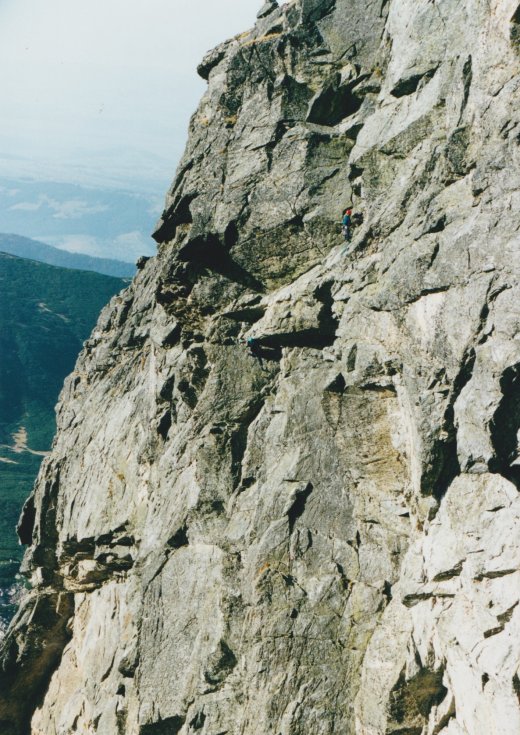|
LIMESTONE ROCKS OF POLISH JURA I grew up in Kraków,which is surrounded by limestone rocks of Polish Jura, a part of Jurassic system of south-central Poland. It is also close to the highest range of the Carpathians, the High Tatras. My climbing adventures started from hiking, then naturally advanced to scrambling, then - in my early twenties - upgraded to me scrambling solo in a terrain than in retrospect calls for the use of climbing equipment. After one particularly terrifying and slightly unintended solo scramble, I swore to myself to take the climbing class before I invevitably earn a Darwin award. So I joined the Kraków section of the Polish Association of Alpinism and completed basic climbing and mountaineering courses. Limestone is fantastic for climbing but there is a catch. Brand new routes are painfully sharp. That changes quickly, when thousands of climbers polish every edge. I was lucky enough to participate in a couple of first ascents, and for some time the routes were kept relatively secret. After a climbing guidebook got published, it only took 3-4 years for the brand new routes to turn into a skating rink. The only hope is that with time, people will flock over another group of rocks, the natural erosion will kick in, and the routes would become usable again. There are plenty of routes for everyone, at any difficulty level. About climbing in Polish Jura in Rock and Ice magazine...
|
|
|
The High Tatras are the tallest range of the Carpathians, located on the border between Poland and Slovakia. Granite walls of High Tatras are the climbers paradise. Glaciers are long gone from the Tatras, approaches to walls are short, and there is a large tourist base on both sides of the mountains. Tatras are no Yosemite though, granite is not that pure, and - guess what - there is weather. Weather: one predictable thing about weather in Tatras is that you can get any weather any time, and that thunderstorms are frequent and violent. Early and mid summer there is usually a thunderstorm in the afternoon every day, so the rule of thumb is to leave early and come back before the storm. The best stable weather is in late August and first half of September. You can get a serious snow storm any time of the year. The popular hiking trails can get extremely crowded but once you off trails on a climbers path, it can be surprisingly quiet. To climb in Polish Tatras, you need a membership in some official mountain organization (like UIAA or AAC)- the rangers may ask you to show a proof of valid membership and they will ticket if you don't have one. In Slovakia - climbers are "allowed" to climb independently on routes above the difficulty level 3 (roughly U.S. 5.5 and up), climbs and scrambles class IV and lower V are reserved for guided tours and these guys are pretty serious about it. Rangers will ticket IF they catch you, and you will be pissing off the local climbers who make their living by guiding. You can use the "easy" climbing routes for descent only and to withdraw from routes in case of trouble - as you see, this leaves some room for interpretation... Mountain rescue is free in Poland, but in Slovakia you will pay full price for a helicopter ride (mountain insurance highly recommended). Polish Tatras are a National Park so there are strick rules about everything. Unlike U.S. parks, you can't swim or fish in lakes or pick berries (people do anyways). And you guessed right, they will ticket if they catch you. You can camp only in designated campsites (in Poland they are run by the Polish Mountaineering Association) or stay in mountain hotels and huts. During the peak season it's not easy to get a spot but most time they will let you sleep on the floor (bring your sleeping bag) if there is space.
This beautiful mountain is extremely popular among hikers and climbers. There is a trail with a bit of rock scramble leading to the summit, but also several attractive multipitch climbs. In 1909, Polish composer and one of the early pioneers of alpinism Mieczysław Karłowicz was killed by an avalanche while skiing from north-eastern slope of Mały Kościelec. Click on the picture to enlarge it, look carefully, and you should see 2 climbers (red helmet above the ledge, and a blue helmet on a traverse). This is a super fun route called "Sprężyna" (difficulty level 6, U.S. about 5.9+, maybe 5.10-) with the crux being that overhanging traverse - if you fall you will end up hanging in the air so if you don't have an ascender or a Prusik cord, you're kind of screwed and at the mercy of other climbers. The entire traverse is generouslty bolted (you need trad gear on the remaining pitches). Many years ago, my great friend and climbing mentor Andrzej Skwirczyński (a.k.a. "Skwir") took me on that route to show me the basics of aid climbing. The memory of hanging on ladders on that traverse still gives me hibbie jibbies, especially realizing that some of the gear we were using had a bit of a homemade look. |
|
|
AUSTRIA Stubaier Alpen I have a soft spot in my heart for Tirol. Music festivals, summer workshops and concerts were usually my main reason for visiting. However in summer 1999 me and my friend Ania had the opportunity to spend 3 weeks hiking in Stubaier Alpen. Our base was Gschnitztal, with the impressive pyramid of Gschnitzer Tribulaun towering over the valley. Most of time we would start our trips from the valley floor, hiking up to mountain huts and high passes, occassionally crossing over to the Italian side. 
Gravity Fails. This photo of me was taken by Ania on our hike from Innsbrucker Hütte to Bremer Hütte. We spent the night at Innsbrucker Hutte (2,369 m), and next morning we traversed overd to the neighbouring valley, with an obligatory "Apfelstrudel + hot chocolate" combo at each hut.
Höllental The limestone walls of Höllental with their excellent multi pitch routes, located just outside of Vienna, are a magnet for climbers from around Europe, including weekend warriors like myself and my friends. One “surprise” I remember was the local difficulty rating which seemed to reflect the average difficulty of the entire multipitch route rather than the hardest spot (this is what we were used to). Fortunately we had a strong climber among us who managed to lead the crux and drag us along. Topo: https://www.thecrag.com/climbing/austria/wien-vienna-area/area/344540022 |
|
 West Wall of
West Wall of  girlbot@ewatrebacz.com
girlbot@ewatrebacz.com BabelScores
BabelScores Youtube
Youtube SoundCloud
SoundCloud Facebook
Facebook